Key Developments in the History of
Arch Dams
|
The Roman Empire
|
|
Vallon de Baume
It is rather astonishing that the Romans only sparcely applied the arch in dam
constructions, a design otherwise so masterfully employed in their buildings and bridges.
One of the few true arch dams built by the Romans was located in the Vallon de Baume, France
in order to supply the nearby city with water. The dam was 12 m high and 18 m
long. |
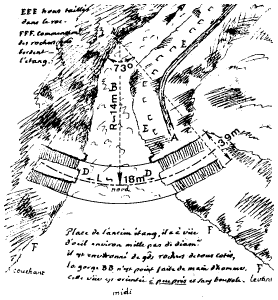
The Vallon de Baume Dam
sketch from Schnitter
courtesy of
A.A. Balkema (#)
|
Mongolian Arch Dams in Iran
|
|
Kebar and Kurit
The Mongolians built the first arch dams since the Romans. The earliest one was built
around 1300 near Kebar, Iran. The Kebar dam was 26 m high, 55 m long.
The arch did not abut against the canyon walls, instead it passed on both
sides into straight wing walls.
The second Mongolian arch dam was built around 1350 in Kurit, Iran. The Kurit dam is
especially remarkable for its extraordinary height of 60 m -- it was the world's highest dam
until the early 1900's. The dam was built in a very narrow canyon and its crest length reached
only 44% of the height. It therefore remained erect, despite the fact that a large segment
of lower half of the vertical downstream face broke away.
|
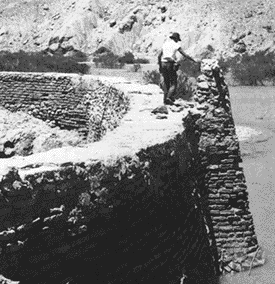
The Kurit Dam
photo from Schnitter
courtesy of
A.A. Balkema (#)
|
Postmedieval Europe
Elche
The first true arch dam in Europe since the Roman times was built from 1632 to 1640 near Elche,
Spain. The Elche dam's main arch was 75 m long at the crest. The Elche dam was designed by Joanes del Temple.
|
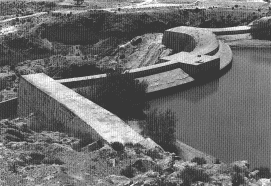
The Elche Dam
photo from Schnitter
courtesy of
A.A. Balkema (#)
|
Radical Designs
A few dams have been experiments in themselves. The La Gage dam in France and the Tolla Dam
in Corsica were both made exceedingly thin in order to provide a full-scale check on the
validity of theoretical analyses when applied to dams approaching the ultimate degree of
slenderness. The two dams are a complete success and have been shown to posses adequate
margins of safety. Whether or not such thin dams are psychologically justifiable is
another matter. |
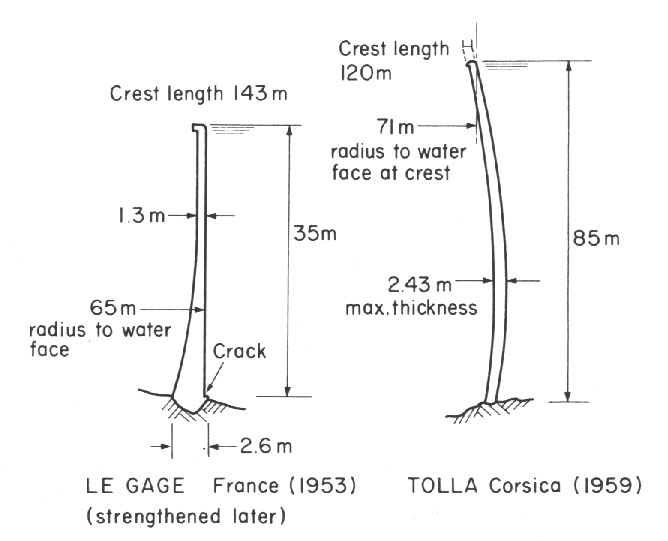
The Tolla and Le Gage Dams
sketch from Thomas
|
The 1960's brought a revival of arch dam construction in the USA,
particularly so after the adoption of the double-curvature design by the
USBR for some of its most important structures like, for example,
143 m high Morrow point dam built in 1968. But in spite
of the high perfection and productivity attained in their construction,
arch dams lost ground in the last few decades.
|

The Morrow Point Dam
photo courtesy of
Bureau of
Reclamation (#)
|
|
Epilogue: A Tragic Display of Strength
The great reserves of strength inherent in an arch dam were dramatically displayed
in 1963 when the reservoir behind Vaiont Dam in Italy was virtually destroyed by a
landslide. Vaiont, at that time the second highest dam in the world, was built
across a narrow gorge on limestone foundations so that the crest 858 feet above
the valley bottom was only 623 feet in length. |
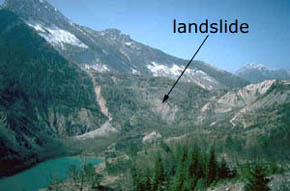
The Vaiont Landslide
photo from Kingston University School of Civil
Engineering (#)
|
|
Some large-scale instability in
the mountainside above the reservoir had been observed earlier by the engineers
during filling; they were allowed to proceed very slowly, and three years later,
on Oct. 9, 1963, with filling still incomplete, about 314 million cubic yards of
soil and rock slid down into the reservoir, sending a tremendous volume of water to a
height of 853 feet on the opposite side of the valley. The flood overtopped the dam to
a depth of 328 feet and surged down the valley, causing a major tragedy, the destruction
of several villages with a large loss of life. Yet, only superficial damage was caused to
the dam, which, at its crest, is about 11.2 feet thick.
 
|


